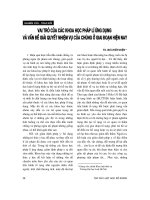SLIDE KHÓA học PHÁP lý CHƯƠNG 3 the investigator s office and laboratory
Bạn đang xem bản rút gọn của tài liệu. Xem và tải ngay bản đầy đủ của tài liệu tại đây (1.49 MB, 44 trang )
.c
om
du
o
ng
th
an
co
ng
Guide to Computer Forensics
and Investigations
Fourth Edition
cu
u
Chapter 3
The Investigator’s Office and
Laboratory
CuuDuongThanCong.com
/>
.c
om
Objectives
cu
u
du
o
ng
th
an
co
ng
• Describe certification requirements for computer
forensics labs
• List physical requirements for a computer forensics
lab
• Explain the criteria for selecting a basic forensic
workstation
• Describe components used to build a business
case for developing a forensics lab
CuuDuongThanCong.com
/>
.c
om
ng
co
cu
u
du
o
ng
th
an
Understanding Forensics Lab
Certification Requirements
CuuDuongThanCong.com
/>
ng
• Computer forensics lab
.c
om
Understanding Forensics Lab
Certification Requirements
th
an
co
– Where you conduct your investigation
– Store evidence
– House your equipment, hardware, and software
du
o
ng
• American Society of Crime Laboratory
Directors (ASCLD) offers guidelines for:
cu
u
– Managing a lab
– Acquiring an official certification
– Auditing lab functions and procedures
CuuDuongThanCong.com
/>
.c
om
Identifying Duties of the Lab Manager
and Staff
u
du
o
ng
th
an
co
Set up processes for managing cases
Promote group consensus in decision making
Maintain fiscal responsibility for lab needs
Enforce ethical standards among lab staff members
Plan updates for the lab
Establish and promote quality-assurance processes
Set reasonable production schedules
Estimate how many cases an investigator can
handle
cu
–
–
–
–
–
–
–
–
ng
• Lab manager duties:
CuuDuongThanCong.com
/>
.c
om
Identifying Duties of the Lab Manager
and Staff (continued)
ng
• Lab manager duties (continued):
ng
th
an
co
– Estimate when to expect preliminary and final results
– Create and monitor lab policies for staff
– Provide a safe and secure workplace for staff and
evidence
du
o
• Staff member duties:
cu
u
– Knowledge and training:
• Hardware and software
• OS and file types
• Deductive reasoning
CuuDuongThanCong.com
/>
.c
om
Identifying Duties of the Lab Manager
and Staff (continued)
ng
• Staff member duties (continued):
ng
th
an
• Technical training
• Investigative skills
• Deductive reasoning
co
– Knowledge and training (continued):
du
o
– Work is reviewed regularly by the lab manager
cu
u
• Check the ASCLD Web site for online manual and
information (but it's not free, as far as I can tell)
CuuDuongThanCong.com
/>
.c
om
Lab Budget Planning
u
du
o
Hardware
Software
Facility space
Trained personnel
cu
–
–
–
–
ng
th
an
co
ng
• Break costs down into daily, quarterly, and annual
expenses
• Use past investigation expenses to extrapolate
expected future costs
• Expenses for a lab include:
CuuDuongThanCong.com
/>
.c
om
Lab Budget Planning (continued)
co
ng
• Estimate the number of computer cases your lab
expects to examine
an
– Identify types of computers you’re likely to examine
cu
u
du
o
ng
th
• Take into account changes in technology
• Use statistics to determine what kind of computer
crimes are more likely to occur
• Use this information to plan ahead your lab
requirements and costs
CuuDuongThanCong.com
/>
.c
om
Lab Budget Planning (continued)
• Check statistics from the Uniform Crime Report
ng
– For federal reports, see www.fbi.gov/ucr/ucr.htm
an
co
• Identify crimes committed with specialized software
• When setting up a lab for a private company, check:
du
o
ng
th
– Hardware and software inventory
– Problems reported last year
– Future developments in computing technology
cu
u
• Time management is a major issue when choosing
software and hardware to purchase
CuuDuongThanCong.com
/>
cu
u
du
o
ng
th
an
co
ng
.c
om
Lab Budget Planning (continued)
CuuDuongThanCong.com
/>
.c
om
Acquiring Certification and Training
co
ng
• Update your skills through appropriate training
• International Association of Computer Investigative
Specialists (IACIS)
cu
u
du
o
ng
th
an
– Created by police officers who wanted to formalize
credentials in computing investigations
– Only open to law enforcement officers or full-time
civilian employees of law enforcement agencies
– Certified Electronic Evidence Collection Specialist
(CEECS)
– Certified Forensic Computer Examiners (CFCEs)
CuuDuongThanCong.com
/>
.c
om
Acquiring Certification and Training
(continued)
ng
• High-Tech Crime Network (HTCN)
an
co
– Certified Computer Crime Investigator, Basic and
Advanced Level
th
• Basic requires 3 years of experience and 10 cases
cu
u
du
o
ng
– Certified Computer Forensic Technician, Basic and
Advanced Level
CuuDuongThanCong.com
/>
.c
om
Acquiring Certification and Training
(continued)
an
co
ng
Certifications that are available without police
experience
• EnCase Certified Examiner (EnCE) Certification
th
– Link Ch 3d
du
o
– Link Ch 3e
ng
• AccessData Certified Examiner (ACE) Certification
u
• Other Training and Certifications
cu
– High Technology Crime Investigation Association
(HTCIA)
CuuDuongThanCong.com
/>
.c
om
Acquiring Certification and Training
(continued)
ng
• Other training and certifications
–
–
–
–
cu
u
du
o
ng
th
an
co
SysAdmin, Audit, Network, Security (SANS) Institute
Computer Technology Investigators Network (CTIN)
NewTechnologies, Inc. (NTI)
Southeast Cybercrime Institute at Kennesaw State
University
– Federal Law Enforcement Training Center (FLETC)
– National White Collar Crime Center (NW3C)
CuuDuongThanCong.com
/>
du
o
ng
th
an
co
ng
.c
om
CyberSecurity Forensic Analyst
(CSFA)
cu
u
• Steve Hailey's company in Washington State
• 70% of grade based on practical exam
• Three days to complete a case
– Link Ch 3f
CuuDuongThanCong.com
/>
.c
om
Recommended Certifications
du
o
ng
th
an
co
ng
• First get ACE Certification
• Then get CSFA
• We expect a local opportunity to get the CSFA
within the next few months
• Doug Spindler from PacITPros is working on it
cu
u
– pacitpros.org
– Meetings on the first Tuesday each month
– Extra credit for attending
CuuDuongThanCong.com
/>
.c
om
ng
cu
u
du
o
ng
th
an
co
Determining the Physical
Requirements for a Computer
Forensics Lab
CuuDuongThanCong.com
/>
ng
.c
om
Determining the Physical
Requirements for a Computer
Forensics Lab
du
o
ng
th
an
co
• Most of your investigation is conducted in a lab
• Lab should be secure so evidence is not lost,
corrupted, or destroyed
• Provide a safe and secure physical environment
• Keep inventory control of your assets
cu
u
– Know when to order more supplies
CuuDuongThanCong.com
/>
.c
om
Identifying Lab Security Needs
• Secure facility
ng
th
an
Small room with true floor-to-ceiling walls
Door access with a locking mechanism
Secure container
Visitor’s log
du
o
–
–
–
–
co
• Minimum requirements
ng
– Should preserve integrity of evidence data
cu
u
• People working together should have same access
level
• Brief your staff about security policy
CuuDuongThanCong.com
/>
.c
om
Conducting High-Risk Investigations
th
– TEMPEST facilities
an
co
ng
• High-risk investigations (national security or
murder) demand more security to prevent
computer eavesdropping
du
o
ng
• Electromagnetic Radiation (EMR) proofed
• />
u
– TEMPEST facilities are very expensive
cu
• You can use low-emanation workstations instead
CuuDuongThanCong.com
/>
ng
• Known as evidence lockers
.c
om
Using Evidence Containers
an
co
– Must be secure so that no unauthorized person can
easily access your evidence
th
• Recommendations for securing storage containers:
cu
u
du
o
ng
– Locate them in a restricted area
– Limited number of authorized people to access the
container
– Maintain records on who is authorized to access
each container
– Containers should remain locked when not in use
CuuDuongThanCong.com
/>
.c
om
Using Evidence Containers
(continued)
ng
• If a combination locking system is used:
cu
u
du
o
ng
th
an
co
– Provide the same level of security for the
combination as for the container’s contents
– Destroy any previous combinations after setting up a
new combination
– Allow only authorized personnel to change lock
combinations
– Change the combination every six months or when
required
CuuDuongThanCong.com
/>
.c
om
Using Evidence Containers
(continued)
• If you’re using a keyed padlock:
cu
u
du
o
ng
th
an
co
ng
– Appoint a key custodian
– Stamp sequential numbers on each duplicate key
– Maintain a registry listing which key is assigned to which
authorized person
– Conduct a monthly audit
– Take an inventory of all keys
– Place keys in a lockable container
– Maintain the same level of security for keys as for evidence
containers
– Change locks and keys annually
– Don't use a master key for several locks
CuuDuongThanCong.com
/>
.c
om
Using Evidence Containers
(continued)
an
co
ng
• Container should be made of steel with an internal
cabinet or external padlock
• If possible, acquire a media safe
th
– Protects evidence from fire damage
cu
u
du
o
ng
• When possible, build an evidence storage room in
your lab
• Keep an evidence log
– Update it every time an evidence container is
opened and closed
CuuDuongThanCong.com
/>









